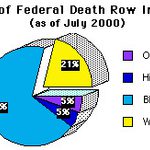THE FEDERAL DEATH PENALTY SYSTEM:
A STATISTICAL SURVEY
(1988 – 2000)
A Summary of the Report on the Federal Death Penalty
by the Death Penalty Information Center
Introduction
This study was conducted by the U.S. Department of Justice at the request of President Clinton and was released on September 12, 2000. The purpose of the study was to describe the Department of Justice’s decision-making process in seeking the death penalty, and to present statistical information focusing on the racial, ethnic and geographical distribution of defendants and their victims at particular stages of the process.
The federal death penalty was reinstated in November 1988 with the introduction of the Drug Kingpin Act. Prior to 1995, U.S. Attorneys notified the Attorney General only when they affirmatively wished to seek the death penalty against a defendant in a federal case. From 1988 to the end of 1994, U.S. Attorneys sought approval from the Attorney General to seek the death penalty in 52 cases and received approval in 47 cases. There is no record for this period of how many cases of capital-eligible offenses the U.S. Attorneys considered overall.
In 1995, following the adoption of the Violent Crime Control and Law Enforcement Act including the Federal Death Penalty Act, the Department of Justice adopted a protocol that required U.S. Attorneys to submit for review all cases in which a defendant is charged with a capital-eligible offense, regardless of whether the U.S. Attorney actually recommends seeking the death penalty in that case. The submissions are considered by a Review Committee of senior Justice Department attorneys, which makes a recommendation to the Attorney General. From January 27, 1995 to July 20, 2000, U.S. Attorneys submitted 682 cases for review and the Attorney General ultimately authorized seeking the death penalty in 159 of these cases.
As a result of the differences in procedure, the data in the report are categorized as “pre-protocol” (1988 – 1994) or “post-protocol” (1995 – 2000). The post-protocol data provides a fuller picture of the decision making process.
The report presents some troubling statistics.
Racial Disparities in Seeking the Death Penalty

From 1995 – 2000, 80% of all the federal cases submitted by U.S. Attorneys involved defendants from minorities.
| TOTAL | White | Black | Hispanic | Other | |
| Number of cases submitted | 682 | 134 | 324 | 195 | 29 |
| Percent | 100% | 20% | 48% | 29% | 4% |
Even after review by the Attorney General, 72% of the cases approved for death penalty prosecution involved minority defendants.
Race of Victim Disparities
Of the 677 homicide defendants submitted for review from 1995 to 2000, 500 (74%) were charged with intraracial homicides (i.e., each defendant was of the same race/ethnicity as all victims)and 177 (26%) were charged with interracial homicides (i.e., each defendant was of a different race/ethnicity as at least one victim.)
| U.S. Attorneys Recommended Seeking the Death Penalty | ||
| White Defendant | 35% of cases involving non-White victims | |
| Black Defendant |
36% of cases involving non-Black victims | |
U.S. Attorneys were almost twice as likely to recommend seeking the death penalty for a Black defendant when the victim was non-Black as when the victim was Black. In comparison, U.S. Attorneys were slightly less likely to recommend seeking the death penalty for a White defendant when the victim was non-White rather than White.

Racial Disparities in Plea Agreements
These statistics show the racial breakdown of the cases in which defendants entered into an agreement resulting in a guilty plea and a lesser sentence after the Attorney General authorized seeking the death penalty.
From 1995 – 2000, the Attorney General authorized the seeking of the death penalty for 159 defendants. Of these, 51 defendants (32%) entered into plea agreements. The rates for individual racial/ethnic groups were as follows:
- 48% for White defendants (21 out of 44 authorized)
- 25% for Black defendants (18 out of 71 authorized)
- 28% for Hispanic defendants (9 out of 32 authorized)
- 25% for Other defendants (3 out of 12 authorized)
In the post-protocol period, a White defendant was almost twice as likely to be given a plea agreement resulting in a withdrawal of intent to seek the death penalty than Black or Other defendants, and considerably more likely than a Hispanic defendant to do so.
Race of Federal Death Row Inmates

As of July 2000, 19 defendants were under a federal sentence of death — 79% were members of minorities.
| Total | White | Black | Hispanic | Other | |
| Number | 19 | 4 | 13 | 1 | 1 |
| Percent | 100% | 21% | 68% | 5% | 5% |
Geographic Disparities in Seeking the Death Penalty
The survey also reported large disparities in the geographical distribution of federal death penalty recommendations.
From 1995 – 2000, 42% (287 out of 682) of the federal cases submitted to the Attorney General for review came from just 5 of the 94 federal districts.
Including the 21 districts that have never submitted a case for review by the Attorney General, from 1995 – 2000, 40 of the 94 federal districts never recommended seeking the death penalty for any defendant.
Conclusion
Defendants from minorities are over represented at every stage of the federal process. The vast majority of federal cases involve minority defendants. 72% of capital cases are pursued against minority defendants. Minority defendants in federal capital cases are less likely to be given a plea bargain. Minorities make up 79% of federal death row.
The federal death penalty is applied less often when the victim was a member of a minority. U.S. Attorneys are more likely to recommend the death penalty when the victim of a murder was white.
The federal death penalty is geographically arbitrary, with a very small number of federal districts prosecuting the majority of federal cases.
Read the entire report, “The Federal Death Penalty System: A Statistical Survey (1988 – 2000).”


